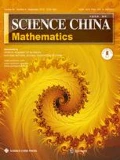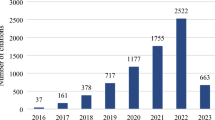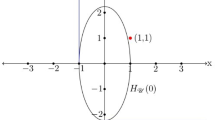Abstract
It is very powerful for constructing nearly saturated factorial designs to characterize fractional factorial (FF) designs through their consulting designs when the consulting designs are small. Mukerjee and Fang employed the projective geometry theory to find the secondary wordlength pattern of a regular symmetrical fractional factorial split-plot (FFSP) design in terms of its complementary subset, but not in a unified form. In this paper, based on the connection between factorial design theory and coding theory, we obtain some general and unified combinatorial identities that relate the secondary wordlength pattern of a regular symmetrical or mixed-level FFSP design to that of its consulting design. According to these identities, we further establish some general and unified rules for identifying minimum secondary aberration, symmetrical or mixed-level, FFSP designs through their consulting designs.
Similar content being viewed by others
References
Fries, A., Hunter, W. G., Minimum aberration 2k-p designs, Technometrics, 1980, 26: 225–232.
Chen, J., Sun, D. X., Wu, C. F. J., A catalogue of two-level and three-level fractional factorial designs with small runs, Internat. Statist. Rev., 1993, 61(1): 131–145.
Tang, B., Wu, C. F. J., Characterization of minimum aberration 2n-k designs in terms of their complementary designs, Ann. Statist., 1996, 25: 1176–1188.
Suen, C. Y., Chen, H., Wu, C. F. J., Some identities on q n-m designs with application to minimum aberrations, Ann. Statist., 1997, 25(3): 1176–1188.
Wu, C. F. J., Zhang, R. C., Minimum aberration designs with two-level and four-level factors, Biometrika, 1993, 80(1): 203–209.
Wu, C. F. J., Zhang, R. C., Wang, R. G., Construction of asymmetrical orthogonal arrays of the type OA \((s^k , (s^{r_1 } )^{n_1 } \cdots (s^{r_t } )^{n_t } )\), Statist. Sinica, 1992, 2: 203–219.
Zhang, R. C., Shao, Q., Minimum aberration (s 2)s n-k designs, Statist. Sinica, 2001, 11: 213–223.
Mukerjee, R., Wu, C. F. J., Minimum aberration designs for mixed Factorials in terms of complementary sets, Statist. Sinica, 2001, 11: 225–239.
Ai, M. Y., Zhang, R. C., Characterization of minimum aberration mixed factorials in terms of consulting designs, Statist. Papers, 2004, 46(2): 157–171.
Chen, H., Cheng, C. S., Theory of optimal blocking of 2n-m designs, Ann. Statist., 1999, 27(6): 1948–1973.
Zhang, R. C., Park, D. K., Optimal blocking of two-level fractional factorial designs, J. Statist. Plann. Infer., 2000, 91: 107–121.
Ai, M. Y., Zhang, R. C., Theory of minimum aberration blocked regular mixed factorial designs, J. Statist. Plann. Infer., 2004, 126(1): 305–323.
Ai, M. Y., Zhang, R. C., Theory of optimal blocking of nonregular factorial designs, Canad. J. Statist., 2004, 32(1): 57–72.
Box, G. E. P., Jones, S., Split-plot designs for robust product experimentation, J. Appl. Statist., 1992, 19: 3–26.
Bingham, D., Sitter, R. R., Minimum aberration two-level fractional factorial split-plot designs, Technometrics, 1999, 41(1): 62–70.
Bingham, D., Sitter, R. R., Some theoretical results for fractional factorial split-plot designs, Ann. Statist., 1999, 27(4): 1240–1255.
Ai, M. Y., Zhang, R. C., Multistratum fractional factorial split-plot designs with minimum aberration and maximum estimation capacity, Statist. Probab. Letters, 2004, 69(2): 161–170.
Ai, M. Y., He, S. Y., Theory of optimal blocking for fractional factorial split-plot designs, Sci. China, Ser. A. 2005, 48(5): 649–656.
Bingham, D., Sitter, R. R., Design issues in fractional factorial split-plot experiments, J. Quality Technology, 2001, 33(1): 2–15.
Mukerjee, R., Fang, K. T., Fractional factorial split-plot designs with minimum aberration and maximum estimation capacity, Statist. Sinica, 2002, 12: 885–903.
MacWilliams, T. J., Sloane, N. J. A., The Theory of Error-Correcting Codes, Amsterdam: North-Holland, 1977.
Roman, S., Coding and Information Theory, New York: Springer, 1992.
Peterson, W. W., Weldon, E. J., Error-Correcting Codes, Cambridge: MIT Press, 1972.
Author information
Authors and Affiliations
Rights and permissions
About this article
Cite this article
Ai, M., Zhang, R. Minimum secondary aberration fractional factorial split-plot designs in terms of consulting designs. SCI CHINA SER A 49, 494–512 (2006). https://doi.org/10.1007/s11425-006-0494-x
Received:
Accepted:
Published:
Issue Date:
DOI: https://doi.org/10.1007/s11425-006-0494-x




